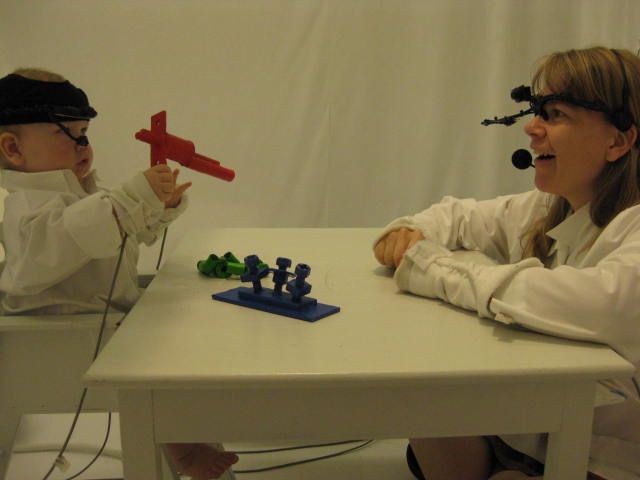Infants Learn to Pay Attention (or Not) From Watching Mom and Dad
Parents who focus on play may help babies develop critical skills that predict future success
/https://tf-cmsv2-smithsonianmag-media.s3.amazonaws.com/filer/ca/46/ca46f02d-0710-4888-b123-f8537fa46791/istock_000057035222_large.jpg)
Your infant child is watching what grabs your attention—so perhaps it’s time to put down that phone and focus on the toy of your baby’s choice.
Doing so may boost the kid's brain development, and chances of future success, by teaching him or her how to keep their own attention focused on the task at hand, a new study shows. Infants pay more attention to objects while playing when their caregivers do the same, but their eyes wander when a parent’s own gaze is distracted. The findings, published today in Current Biology, suggest that caregiver attention can aid in the development of sustained attention span in very young kids.
Curious young children are known for their short attention spans, but their ability to sustain focus usually grows along with their bodies. Scientists have sometimes viewed this cognitive growth as a function of the individual brain, but the new study suggests that social interaction plays a role. “Real-time effects of parent behavior can really be helpful as they expand a child’s attention,” says Chen Yu, a professor of psychological and brain sciences at Indiana University.
Studies in kids from age 1 through grade school have shown that greater attention spans, even at a very young age, are a good predictor of future achievement. Focused attention also helps key cognitive achievements such as problem solving and language acquisition.
Based on these past findings, Yu and IU colleague Linda Smith evaluated attention span in infants at play. The team employed head-mounted cameras to track the eye movements and gazes of three dozen parents and infants aged 11 to 13 months, who were turned loose in a play space and asked to simply play as they would at home with brightly colored plastic objects.
This kind of “free play” data enabled Yu and Smith to chart childhood concentration and learning in ways that traditional experiments involving a single child at work on a computer or other task could not, notes cognitive neuroscientist Sam Wass, of Cambridge University and the University of East London. “They show that what the parent is paying attention to, minute by minute and second by second, actually influences what the child is paying attention to,” he notes. “These kinds of social influences on attention are potentially very important [and] most scientists tend to ignore them.”

When parents paid attention to a toy during play, the infants also continued to focus on it—even after the mom or dad had turned elsewhere. The authors likened this effect to the way a parent will initially hold the back of a bike while their child learns to peddle before letting go and sending them off on their own.
When infants and caregivers both paid attention to an object for more than 3.6 seconds, those infants continued to gaze at it after the parents turned away almost four times longer than infants with inattentive parents. And though the duration of each example is only a few seconds or so, repetition over days and months of such “joint attention” episodes—the time when caregiver and child are both focused on an object—creates a significant cumulative impact, the scientists say.
“Joint attention turns out to be a teaching moment,” says John Colombo, a psychologist at the University of Kansas, who wasn't involved in the study. It's “a moment for the adult to attach a label to a object and a time when the child is sort of primed to learn the label.”
The results from Yu and Smith also show that not all such interactions are equal. Different parenting styles produced very different levels of infant attention, suggesting that how people play is as important in making the effort. Attempting to focus a child's attention on objects by holding them out, naming them and trying to interest the child in them, worked only some of the time. The more successful parents were attentive and engaged but played by letting the child lead.
“If parents try to lead by getting the child’s attention on an object, “this effort may or may not be successful, because children may or may not follow their parent,” Yu says. The easier path is for a parent to follow a child’s interest.
“One of the principles of joint attention that's come out over the years is that you can't force it,” Colombo adds. “It's most effective as a teaching moment when the parent clues into what the child is attending to.”
The results could help scientists devise ways to help infants develop the critical skill of sustained attention. Yu is particularly interested in how this work may be applied to children with autism. “If our findings can be generalized to this special population, then this basic science research program may suggest some principled ways on how parents [can] interact with their child on a daily basis to train their attention system, through moment-to-moment real-time behaviors,” he notes.
But the many factors involved in cognitive development make the process a complicated one. Siblings, for instance, often display individual differences in attention even when raised by the same parents. Many factors, intrinsic and external alike, could account for these differences, Yu notes, though some of them may include parent behavior.
“It is probably true that parents spend less time on younger siblings than when they had only one child,” he says, “but there are also interactions between siblings which are different [from] parent-child interaction but also play a role in their development.”
Related: The Many Ways Baby Talk Gives Infant Brains a Boost